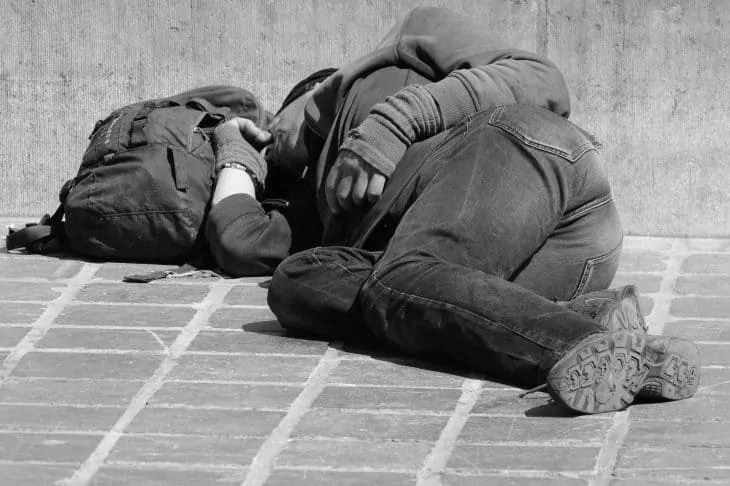
- Definition: Condition of people without a regular dwelling
- Statistics: 633,782 homeless people in the US
- statistics: 100 million homeless people worldwide
- Organizations: Housing First, Back on My Feet, Pathways to Housing
- Issues: Social, economic, legal, health
- Typical Homeless Person: Single, middle-aged man who is a member of a minority group
- Music: Only a Hobo by B. Dylan, Brothers Under the Bridges by Bruce Springsteen
- Movies: No Place Like Home, Life Stinks, With Honors
- Books: The Cop and the Anthem by Henry, Ironweed by Kennedy, Stone Cold by Swindells
- Famous People: Jim Carrey, Halle Berry, Dr. Phil, Daniel Craig, Jewel
- Statistics: 650,000 People in the US are Homeless at Any Given Time
- Definition: The Definition of Homelessness Is Broader than Many Imagine
- Statistics: Some Groups Are More Likely to End up Homeless than Others
- Causes: Lack of Affordable Housing Is the Primary Cause of Homelessness
- Causes: Domestic Violence Is the Main Cause for Homelessness among Women
- Causes: The Reasons for Homelessness among Youths Are Numerous and Extremely Varied
- Statistics: About 25% of All Homeless People Are Children
- Statistics: A Stunningly High Percentage of Veterans Are Homeless
- Health: Many Homeless People Suffer from Untreated Mental Illnesses
- Statistics: Homelessness Is on the Rise in Most Countries of the World
- Homeless People Find Shelter in a Number of Places
- Not Having a Home Brings Problems that Most People Don’t Even Think Of
- Homeless People Are Often Perceived as Violent, but Are in Fact Victims of Attacks
- Homelessness Is Now Considered a Crime in Many Countries of the World
- There Are Many Potential Solutions for Homelessness
- People Use a Range of Negative Terms to Describe the Homeless
- Providing People with Homes Can Actually Cost Less than Leaving Them Homeless
- A Surprisingly High Percentage of Homeless People Have At Least Some Education
- Homelessness Is More Common in Urban Areas than in Rural Ones
- Public Libraries Play an Important Role When It Comes to the Homeless Population
Homelessness Facts Infographics
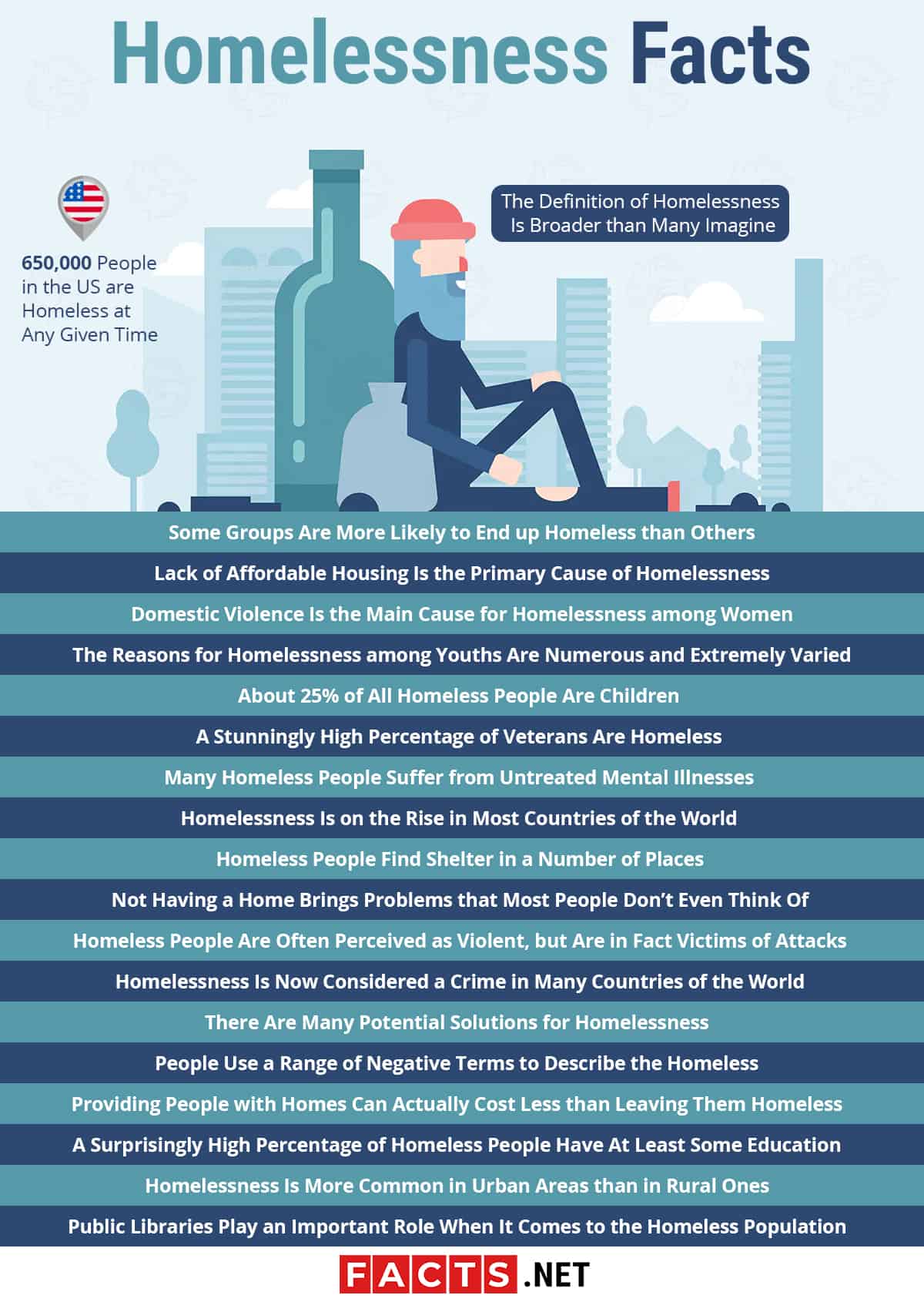
650,000 People in the US are Homeless at Any Given Time
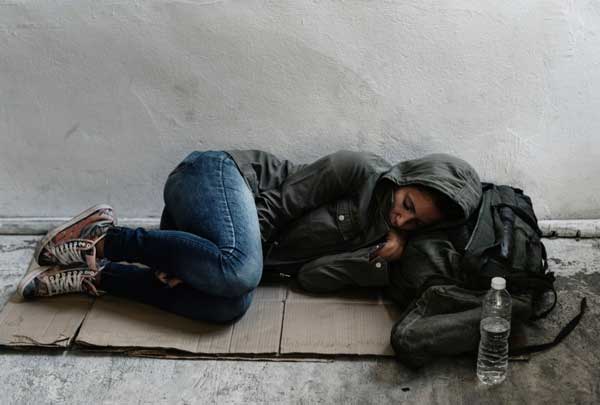
Homelessness facts reveal that on any given night, almost 650,000 people experience homelessness in the US. Among them, 37% have families, 25% suffer from mental illnesses (such as schizophrenia, bipolar disorder, depression and others), 13% are homeless due to fleeing from domestic violence, 12% are veterans, and over 20% are children under the age of 18.
But only 13% of those who experience homelessness on any given night are chronically homeless, and homelessness has declined greatly since 2007 – by 11% among those homeless occasionally, and 30% among the chronically homeless.
The Definition of Homelessness Is Broader than Many Imagine
One of the most important questions homelessness facts deal with is what being homeless actually means. According to the Department of Housing and Urban Development, there are four basic categories of homelessness: people who are living in a place not meant for human habitation, in emergency shelter, in transitional housing, or those who are exiting an institution where they temporarily resided; people who are losing their primary nighttime residence (including motels, hotels or other possible residences) within 14 days and lack the necessary resources or support networks to remain in housing; families with children or unaccompanied youths who are unstably housed and likely to continue to be; and people who are fleeing (or attempting to flee) domestic violence and have no other residence and lack the resources or support networks to obtain another permanent housing.
Some Groups Are More Likely to End up Homeless than Others
Homelessness facts reveal that a typical sheltered homeless person is a single man between 31 and 50 years of age, and who is a member of a minority group (often African-American, Native American, or Hispanic). In addition to these characteristics, more than 1 in 3 homeless people has a disability.
But there are many people outside these groups who suffer from homelessness too. For example, 25% of homeless people are single women, 23% are families with children, and 38% are Caucasian.
Lack of Affordable Housing Is the Primary Cause of Homelessness
Homelessness facts also reveal the most common cause for this unfortunate situation – according to the US Conference of Mayors, the most common reason for homelessness among individuals and families is the lack of affordable housing, followed by poverty and unemployment. The mayors also propose solutions to these common causes: more housing for persons with disabilities, more employment opportunities, and more assisted housing units.
But unfortunately – and despite all efforts described above -, there are now fewer placer for poor people to rent than in the past. The US need at least 7 million additional affordable apartments for families and individuals with low incomes so that they would not need to spend more than half of their monthly income on rent alone.
Domestic Violence Is the Main Cause for Homelessness among Women

Women who are temporarily or chronically homeless often find themselves in this challenging situation due to domestic violence. According to the National Law Center on Homelessness and Poverty (NLCHP), more than 90% of homeless women were (or are) victims of brutal physical or sexual abuse.
Women, and women with families, make up the fastest growing group of the homeless population in the USA, and represent the majority of homeless people in rural areas nationwide. In addition to domestic violence, other common factors that cause homelessness among women include their role as primary caregivers for children, divorces, and the decline of the welfare state.
The Reasons for Homelessness among Youths Are Numerous and Extremely Varied
Homelessness facts reveal that a sizeable part of the youth population is homeless nowadays, and the reasons for that are many. The most common reasons for homelessness among young people include: being kicked out of the home by parents, unavailability of employment opportunities, lack of healthcare, disability, substance abuse, social exclusion, domestic violence, forced eviction and relationship breakdowns. The global economic crisis only deepened the issues of youth homelessness, and governments across the globe are forced to take care of young people who are not able to provide for themselves.
About 25% of All Homeless People Are Children
Homelessness facts reveal a shocking truth that 1 in 4 homeless persons is a child under 18 years of age. This means that around 150,000 homeless people in the US are children, and thousands of them are unaccompanied. If the definition of homeless children is broadened, so that it contains not only those living in shelters or transitional housing, but also all those who are forced to share housing with others due to economic hardships, those who live in cars, parks, public transportation facilities and those who are waiting for foster-care placement, the USA had more than 1,000,000 homeless children in 2014.
A Stunningly High Percentage of Veterans Are Homeless

Homelessness facts reveal that veterans, who have risked their lives for the US, are often homeless. In fact, tens of thousands of veterans are homeless at the moment, with over 57,000 of them being chronically, not just occasionally, homeless. Some 60% of them live in shelters, and the remaining 40% on the streets. Almost 10% of homeless veterans in the US are women.
But the changes in the trend in recent years give some hope – between 2009 and 2014, the number of homeless veterans fell by almost 25,000; 5,000 between 2013 and 2014.
Many Homeless People Suffer from Untreated Mental Illnesses
Statistics show that around 6% of the general population suffers from a severe mental illness, but the proportion is much higher when talking about the homeless population. Between 20 and 25% of all homeless people suffer from a severe mental illness. In addition to this, 35% of all homeless people have, or have had, a substance abuse problem, with 80% of them experiencing lifelong alcohol or drug problems. Around 50% of homeless people also self-medicate, often making their mental and physical health even worse.
Homelessness Is on the Rise in Most Countries of the World
More than 100 million people are estimated to be homeless worldwide, but since each country has its own approach to recording homeless statistics, and since it is difficult to measure the full extent of homelessness, these numbers are not completely trustworthy. And which country is the home to most homeless people? The United States has around 650,000 homeless people, Australia around 100,000, and Japan between 100,000 and 200,000. The UK has around 100,000 households in temporary accommodation, and over 10,000 rough sleepers, and the EU as a whole has around 3,000,000 homeless people. Statistics in the developing countries – if they even exist – are very unreliable, but it is clear that there are millions of homeless adults and children in countries such as Nigeria, South Africa, China, India and many others.
Homeless People Find Shelter in a Number of Places
Homelessness facts also reveal various places where homeless people might seek refuge in addition to homeless shelters. The simplest refuges are improvised outdoors – sleeping on the ground, in sleeping bags, in tents, in cardboard boxes, in dumpsters or on benches in parks. Some homeless individuals join others and together create tent cities – campsites with numerous tents or improvised tents (using tarpaulins, blankets, sheets) – or shanty towns, which are ad hoc dwelling sites, usually made out of cheap wood and created near rail yards or interstates.
Other common options include sleeping in cars, abandoned buildings and underground tunnels, with the Japanese starting a new trend – approximately 5,000 homeless people in Japan now live and sleep in 24-hour internet cafes.
Not Having a Home Brings Problems that Most People Don’t Even Think Of
In addition to the obvious challenges – lacking personal shelter, warmth and safety – homeless people also have to face several other problems, including medical problems, sleep problems, carrying all their possessions with them all the time for safekeeping, personal hygiene problems, clothes cleaning problems, food problems (obtaining, preparing and storing), hostility from others, no mailing address, limited access to education, almost non-existent employment opportunities, violence on the streets, limited social interactions, limited access to communication technology, psychological problems connected to rejection and many others that most of us can’t even imagine…
Homeless People Are Often Perceived as Violent, but Are in Fact Victims of Attacks

One of the biggest myths connected to homeless people is that they are frequently violent, but in reality they are often victims of violence themselves. There are over 100 violent attacks on homeless people reported each year (with hundreds more that go unreported) and the trend shows that there are likely to be more in the future. Statistics vary greatly, but approximately 20 to 30% of these attacks result in death.
One case that was highly publicized occurred in 2014 in Albuquerque, New Mexico, where three boys, aged 15, 16 and 18, brutally attacked two homeless men with bricks and a metal pole. The two homeless men died as a result of the attack.
Homelessness Is Now Considered a Crime in Many Countries of the World
Homelessness facts show that the USA is no exception to this seemingly unfair law. According to a 2014 study of 187 US cities by the National Law Center on Homelessness and Poverty (NLCHP), 24% of cities make it a city-wide crime to beg in public, 33% make it illegal to stand around or loiter in the city, 18% make sleeping in public a crime, 43% make sleeping in a car a crime, and 53% make it illegal to sit or lie down in certain public places. In addition to this, more than 30 cities also passed local legislation that criminalizes feeding the homeless.
The United States has been heavily criticized for its policies on homelessness on various occasions, including the 2014 criticism from the United Nations Human Rights Committee, which noted that cruel, inhuman and degrading treatment of homeless people exhibited in some parts of the USA is in violation of international human rights treaty obligations.
There Are Many Potential Solutions for Homelessness
Among dozens of potentially effective solutions for homelessness in various parts of the world, four in particular are believed to be able to reduce homelessness problems in the future: transitional housing, supportive housing, pedestrian villages and various government initiatives.
Transitional housing is already in use, offering temporary housing for specific segments of the homeless population (mostly the working homeless) with the intention to transition its residents into permanent and affordable housing. Supportive housing is a combination of housing and services that aim to help people live more stable and more productive lives. This form of support is available mainly to those with low incomes, substance abuse issues, mental illness, other serious health issues, or other serious challenges that prevent them from leading a successful life. Pedestrian villages are a relatively new (2007) proposal to tackle homelessness in the US, and are perceived by many as controversial. Proposed by urban designer and social theorist Michael E. Arth, pedestrian villages would provide complete care for temporarily and permanently homeless adults, and would also serve as an alternative to jail, providing various work opportunities to improve the social and financial aspects of homeless life. Various government initiatives are in place across the world, and include program funding that can solve homelessness issues temporarily or permanently.
People Use a Range of Negative Terms to Describe the Homeless
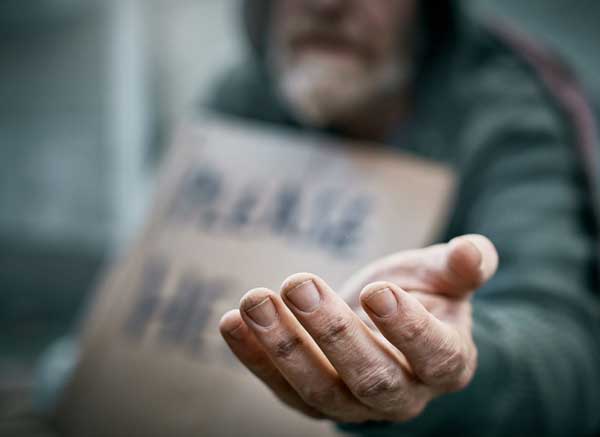
Homelessness facts reveal a broad choice of terms, some socially acceptable and some degrading, that are used to describe homeless people. Many people already know English terms, such as beggars, bums, hobos, street people (or children), tramps or vagabonds. There are various other terms which are popular nowadays, including derelicts, forgotten men, freight train hoppers, internally displaced persons, itinerants, nomads, vagrants, waifs, panhandlers, schnorrers and many others.
Other languages have their own sets of words for naming the homeless – for example, in South Africa they use the term mukomana wekoseri (“the boy from the back”), in Indonesia tunawisma (“no house”), in Bangladesh sharbohara (“having nothing”) and in Spain desamparado (“without protection from other people”).
Providing People with Homes Can Actually Cost Less than Leaving Them Homeless
According to a 2010 study called Project HOME, investing in long-term (not temporary) housing solutions for chronically homeless individuals costs less than necessary critical social services. The savings can be as high as $7,700 per homeless person per year!
Similarly, a 2013 study by the Central Florida Commission on Homelessness concluded that every homeless person costs over $30,000 a year (through transport costs, costs of jail stays, hospitalization and emergency health care, and salaries of law-enforcement officers and healthcare workers), but the cost of permanent supportive housing was estimated at around $10,000 per homeless person per year. This could save hundreds of millions of taxpayers’ dollars in the next decades.
A Surprisingly High Percentage of Homeless People Have At Least Some Education
A typical homeless person is usually perceived by others as having no education and having never earned money by working, but homelessness facts reveal a completely different picture. According to the National Survey of Homeless Assistance Providers and Clients (UIHAC), 21% of homeless people have completed high school, and 27% have completed a higher level of education than high school. And when it comes to working for a living, the study revealed that 44% of homeless people had undertaken at least occasional paid work in the last month. A 2010 study from Alabama even revealed that, on average, homeless people earned about $90 per week, and worked 30 hours per week.
Homelessness Is More Common in Urban Areas than in Rural Ones
Homelessness facts and statistics show that approximately 70% of homeless people live in cities, approximately 20% in suburbs and approximately 10% in rural areas. The reasons for homeless populations living in cities may be many, but the phenomenon can be easily explained by simple statistics. Presuming that the share of homelessness is approximately equal in all types of areas, it is logical that cities produce the most homeless people since they have the highest total population in the first place. Another viable reason for more homeless people living in cities might be that they believe there are more opportunities to get other people’s help in urban areas.
Almost all major US cities have a reasonably high homeless population. Los Angeles, for example, has between 40,000 and 60,000 homeless people (depending on the exact definition of homelessness used), New York City has around 50,000, San Francisco around 10,000 and Washington D.C. around 7,000.
Public Libraries Play an Important Role When It Comes to the Homeless Population
The connection between the homeless population and public libraries might not be apparent at a first glance, but it is definitely there. In many communities, libraries are the only places that offer free use of computers and free internet access. These can be vital services for homeless people. First of all, they offer a free means of fun and information for the homeless population, and second, they allow them to browse for potential employment opportunities and make job applications. That is why the American Library Association created a special policy, Policy 61, which recognizes the important role of libraries in enabling poor and homeless people to participate in society.
Examples of US libraries enabling the homeless to participate in society include the H.O.M.E. Page Café program of the Free Library of Philadelphia, a downtown Los Angeles public library whose employees actively help homeless to find work or create their own small businesses, a San Francisco library that employs a social worker full-time to help homeless visitors, the San Jose University Library, which became one of the first academic libraries to offer various free classes, as well as a place to stay and read, to the homeless, and many others that are prepared to help the less fortunate.
Homelessness Facts — Facts about Homelessness Summary
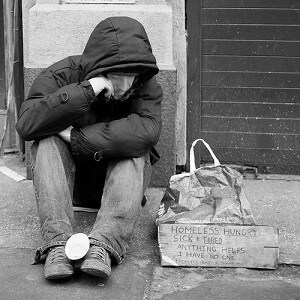 Homeless people are defined as those who do not have a permanent (regular) dwelling and are thus forced to find other solutions for their residence. Some temporarily live with friends or family members, some in improvised housing such as tents, cardboard boxes, simple wooden constructions or on the streets, and some in shelters and other temporary residences provided by government or non-governmental organizations. There are around 650,000 homeless people in the USA today, and most of them live in cities. A typical homeless person is a middle-aged single man with a low level of education, and who is a member of a minority group, but there are also many women and children who are homeless nowadays. Local societies and national organizations are trying to help the homeless population with various programs, but homelessness is still growing in various regions in the world.
Homeless people are defined as those who do not have a permanent (regular) dwelling and are thus forced to find other solutions for their residence. Some temporarily live with friends or family members, some in improvised housing such as tents, cardboard boxes, simple wooden constructions or on the streets, and some in shelters and other temporary residences provided by government or non-governmental organizations. There are around 650,000 homeless people in the USA today, and most of them live in cities. A typical homeless person is a middle-aged single man with a low level of education, and who is a member of a minority group, but there are also many women and children who are homeless nowadays. Local societies and national organizations are trying to help the homeless population with various programs, but homelessness is still growing in various regions in the world.
Was this page helpful?
Our commitment to delivering trustworthy and engaging content is at the heart of what we do. Each fact on our site is contributed by real users like you, bringing a wealth of diverse insights and information. To ensure the highest standards of accuracy and reliability, our dedicated editors meticulously review each submission. This process guarantees that the facts we share are not only fascinating but also credible. Trust in our commitment to quality and authenticity as you explore and learn with us.
